The Individual and Combined Effects of Natural–Human Factors on Forest Fire Frequency in Northeast China
Abstract
:1. Introduction
2. Data and Methods
2.1. Study Area
2.2. Data Sources
- (1)
- Fire data
- (2)
- Canopy moisture content data
- (3)
- Fire weather data
- (4)
- Landform data
- (5)
- Human activity data
2.3. Methods
2.3.1. Structural Equation Modeling (SEM)
2.3.2. Vine Copula
2.3.3. Flowchart of the Study
- (1)
- Collect the study data, including forest fires, weather conditions, canopy moisture content, human activity, and landform.
- (2)
- Use ArcGIS’s “kernel density analysis” to analyze and plot the spatial distribution of forest fires and classify them using the natural breakpoint method. Analyze the temporal distribution of forest fires (annual and monthly). Analyze the yearly changes in the causes of forest fires and the proportion of different causes.
- (3)
- When using SEM models for data analysis, the collected data are first organized and pre-processed, including cleaning, removing outliers and missing values, and standardization. Then, according to the purpose of the study, appropriate variables are selected as latent and explicit variables to establish measurement and structural models. The “lavaan” package in R software was utilized to construct the SEM model, define the relationship between latent and manifest variables, assess the goodness of fit of the model by χ2 test, SRMR, GFI, and CFI, and finally, interpret the contribution and influence of each variable on forest fire frequency based on the path coefficients and correlation statistics of the model degree.
- (4)
- In the analysis using the Vine Copula model, the data were first pre-processed, including the standardization of the data and the fitting of the marginal distributions, and then the variables that have a significant effect on forest fires, were selected from the results of the SEM model, and the appropriate Copula function was chosen to construct the joint probability distribution model, using the selected Copula function to construct the Vine Copula model and fit the model, and the joint probability distribution between different variables and forest fire frequency was obtained by analyzing the results of the model.
3. Results
3.1. The Spatiotemporal Distribution of Forest Fires
3.1.1. The Spatial Distribution of Forest Fires
3.1.2. Temporal Patterns of Forest Fires
3.2. The Factors Affecting Forest Fires
3.2.1. SEM Analysis
3.2.2. Vine Copula Analysis
4. Discussion
4.1. Spatiotemporal Distribution and the Source Type of Forest Fires
4.1.1. Spatial Distribution Analysis of Forest Fires
4.1.2. Temporal Distribution Analysis and the Fire Reason Analysis
4.2. Significant Factors Leading to the Forest Fire Occurrence
5. Conclusions
Author Contributions
Funding
Data Availability Statement
Conflicts of Interest
References
- MacDicken, K.G.; Sola, P.; Hall, J.E.; Sabogal, C.; Tadoum, M.; de Wasseige, C. Global progress toward sustainable forest management. For. Ecol. Manag. 2015, 352, 47–56. [Google Scholar] [CrossRef]
- Njana, M.A.; Mbilinyi, B.; Eliakimu, Z. The role of forests in the mitigation of global climate change: Emprical evidence from Tanzania. Environ. Chall. 2021, 4, 100170. [Google Scholar] [CrossRef]
- Wang, C.; Yan, X.; Chang, Y.; Wang, Q.; Wang, Y.; Malik, A. Understanding the impact of interprovincial trade on forest resources in China. Renew. Sustain. Energy Rev. 2023, 186, 113673. [Google Scholar] [CrossRef]
- Wang, L.; Wang, E.; Mao, X.; Benjamin, W.; Liu, Y. Sustainable poverty alleviation through forests: Pathways and strategies. Sci. Total Environ. 2023, 904, 167336. [Google Scholar] [CrossRef] [PubMed]
- Wang, N.; Bi, H.; Peng, R.; Zhao, D.; Liu, Z. Disparities in soil and water conservation functions among different forest types and implications for afforestation on the Loess Plateau. Ecol. Indic. 2023, 155, 110935. [Google Scholar] [CrossRef]
- Speck, O.; Speck, T. Is a forest fire a natural disaster? Investigating the fire tolerance of various tree species—An educational module. Biomimetics 2024, 9, 114. [Google Scholar] [CrossRef]
- Legge, S.; Rumpff, L.; Garnett, S.T.; Woinarski, J.C.Z. Loss of terrestrial biodiversity in Australia: Magnitude, causation, and response. Science 2023, 381, 622–631. [Google Scholar] [CrossRef]
- Sills, J.; de Oliveira, G.; Chen, J.M.; Stark, S.C.; Berenguer, E.; Moutinho, P.; Artaxo, P.; Anderson, L.O.; Aragão, L.E.O.C. Smoke pollution’s impacts in Amazonia. Science 2020, 369, 634–635. [Google Scholar] [CrossRef]
- Altman, J.; Fibich, P.; Trotsiuk, V.; Altmanova, N. Global pattern of forest disturbances and its shift under climate change. Sci. Total Environ. 2024, 915, 170117. [Google Scholar] [CrossRef]
- Moon, K.; Duff, T.J.; Tolhurst, K.G. Sub-canopy forest winds: Understanding wind profiles for fire behaviour simulation. Fire Saf. J. 2019, 105, 320–329. [Google Scholar] [CrossRef]
- Liu, N. Wildland surface fire spread: Mechanism transformation and behavior transition. Fire Saf. J. 2023, 141, 103974. [Google Scholar] [CrossRef]
- Cannon, J.B.; O’Brien, J.J.; Loudermilk, E.L.; Dickinson, M.B.; Peterson, C.J. The influence of experimental wind disturbance on forest fuels and fire characteristics. For. Ecol. Manag. 2014, 330, 294–303. [Google Scholar] [CrossRef]
- Janssen, T.A.J.; Jones, M.W.; Finney, D.; van der Werf, G.R.; van Wees, D.; Xu, W.; Veraverbeke, S. Extratropical forests increasingly at risk due to lightning fires. Nat. Geosci. 2023, 16, 1136–1144. [Google Scholar] [CrossRef]
- Pinto Neto, O.; Pinto, I.R.C.A.; Pinto Junior, O.; Williams, E.R. Evidence of a link between Amazon fires and lightning. J. Atmos. Sol.-Terr. Phys. 2023, 249, 106095. [Google Scholar] [CrossRef]
- Zhang, B.; Cai, D.; Ai, S.; Wang, H.; Zuo, X. Research on the influencing factors and prevention measures of long-term forest fire risk in Northeast China. Ecol. Indic. 2023, 155, 110965. [Google Scholar] [CrossRef]
- Stocks, B.J.; Mason, J.A.; Todd, J.B.; Bosch, E.M.; Wotton, B.M.; Amiro, B.D.; Flannigan, M.D.; Hirsch, K.G.; Logan, K.A.; Martell, D.L.; et al. Large forest fires in Canada, 1959–1997. J. Geophys. Res. Atmos. 2002, 107, FFR-5. [Google Scholar] [CrossRef]
- Sjöström, J.; Plathner, F.V.; Granström, A. Wildfire ignition from forestry machines in boreal Sweden. Int. J. Wildland Fire 2019, 28, 666–677. [Google Scholar] [CrossRef]
- Syphard, A.D.; Keeley, J.E.; Pfaff, A.H.; Ferschweiler, K. Human presence diminishes the importance of climate in driving fire activity across the United States. Proc. Natl. Acad. Sci. USA 2017, 114, 13750–13755. [Google Scholar] [CrossRef]
- Cetin, M.; Isik Pekkan, Ö.; Ozenen Kavlak, M.; Atmaca, I.; Nasery, S.; Derakhshandeh, M.; Cabuk, S.N. GIS-based forest fire risk determination for Milas district, Turkey. Nat. Hazards 2023, 119, 2299–2320. [Google Scholar] [CrossRef]
- Zheng, Y.; Zhao, Y.; Liu, W.; Liu, S.; Yao, R. An intelligent wireless system for field ecology monitoring and forest fire warning. Sensors 2018, 18, 4457. [Google Scholar] [CrossRef]
- Zheng, X. Advanced Solar-Powered Fire Detection System: A Wireless Sensor Node Approach to Early Warning and Forest Fire Prevention. Highlights Sci. Eng. Technol. 2023, 62, 90–95. [Google Scholar] [CrossRef]
- Barmpoutis, P.; Kastridis, A.; Stathaki, T.; Yuan, J.; Shi, M.; Grammalidis, N. Suburban forest fire risk assessment and forest surveillance using 360-degree cameras and a multiscale deformable transformer. Remote Sens. 2023, 15, 1995. [Google Scholar] [CrossRef]
- Naderpour, M.; Rizeei, H.M.; Ramezani, F. Forest fire risk prediction: A spatial deep neural network-based framework. Remote Sens. 2021, 13, 2513. [Google Scholar] [CrossRef]
- Ma, T.; Liang, Y.; Li, Z.; Liu, Z.; Liu, B.; Wu, M.M.; Lau, M.K.; Fang, Y. Age-related patterns and climatic driving factors of drought-induced forest mortality in Northeast China. Agr. For. Meteorol. 2023, 332, 109360. [Google Scholar] [CrossRef]
- Fan, Q.; Wang, C.; Zhang, D.; Zang, S. Environmental influences on forest fire regime in the greater hinggan mountains, Northeast China. Forests 2017, 8, 372. [Google Scholar] [CrossRef]
- Huang, C.; Feng, J.; Tang, F.; He, H.S.; Liang, Y.; Wu, M.M.; Xu, W.; Liu, B.; Shi, F.; Chen, F. Predicting the responses of boreal forests to climate-fire-vegetation interactions in Northeast China. Environ. Modell. Softw. 2022, 153, 105410. [Google Scholar] [CrossRef]
- Wu, Z.; Li, M.; Wang, B.; Quan, Y.; Liu, J. Using artificial intelligence to estimate the probability of forest fires in Heilongjiang, Northeast China. Remote Sens. 2021, 13, 1813. [Google Scholar] [CrossRef]
- Li, K.; Tong, Z.; Liu, X.; Zhang, J.; Tong, S. Quantitative assessment and driving force analysis of vegetation drought risk to climate change:Methodology and application in Northeast China. Agr. For. Meteorol. 2020, 282–283, 107865. [Google Scholar] [CrossRef]
- Pei, W.; Hao, L.; Fu, Q.; Liu, H.; Ren, Y.; Li, T. Analysis of spring drought in Northeast China from the perspective of atmosphere, snow cover, and soil. Catena 2024, 236, 107715. [Google Scholar] [CrossRef]
- Sandholt, I.; Rasmussen, K.; Andersen, J. A simple interpretation of the surface temperature/vegetation index space for assessment of surface moisture status. Rem. Sens. Environ. 2002, 79, 213–224. [Google Scholar] [CrossRef]
- Deng, L.; Yuan, K. Multiple-group analysis for structural equation modeling with dependent samples. Struct. Equ. Modeling 2015, 22, 552–567. [Google Scholar] [CrossRef]
- Wang, Z.; Fang, K.; Yao, Q. Fire history and its forcing in Northeastern Asia boreal forests. Nat. Hazards Res. 2022, 2, 166–171. [Google Scholar] [CrossRef]
- Abraj, M.; Wang, Y.-G.; Thompson, M.H. A new mixture copula model for spatially correlated multiple variables with an environmental application. Sci. Rep. 2022, 12, 13867. [Google Scholar] [CrossRef] [PubMed]
- Zscheischler, J.; Seneviratne, S.I. Dependence of drivers affects risks associated with compound events. Sci. Adv. 2017, 3, e1700263. [Google Scholar] [CrossRef]
- Doshi, S.C.; Lohmann, G.; Ionita, M. Hotspot movement of compound events on the Europe continent. Sci. Rep. 2023, 13, 18100. [Google Scholar] [CrossRef]
- Pérez-Invernón, F.J.; Gordillo-Vázquez, F.J.; Huntrieser, H.; Jöckel, P. Variation of lightning-ignited wildfire patterns under climate change. Nat. Commun. 2023, 14, 739. [Google Scholar] [CrossRef]
- Yuan, C.; Zhang, Y.; Liu, Z. A survey on technologies for automatic forest fire monitoring, detection, and fighting using unmanned aerial vehicles and remote sensing techniques. Can. J. For. Res. 2015, 45, 783–792. [Google Scholar] [CrossRef]
- Stephens, G.L.; Kahn, B.H.; Richardson, M. The super greenhouse effect in a changing climate. J. Clim. 2016, 29, 5469–5482. [Google Scholar] [CrossRef]
- Guo, F.; Su, Z.; Wang, G.; Sun, L.; Tigabu, M.; Yang, X.; Hu, H. Understanding fire drivers and relative impacts in different Chinese forest ecosystems. Sci. Total Environ. 2017, 605–606, 411–425. [Google Scholar] [CrossRef]
- Chen, Y.; Randerson, J.T.; Morton, D.C.; DeFries, R.S.; Collatz, G.J.; Kasibhatla, P.S.; Giglio, L.; Jin, Y.; Marlier, M.E. Forecasting Fire Season Severity in South America Using Sea Surface Temperature Anomalies. Science 2011, 334, 787–791. [Google Scholar] [CrossRef]
- Martínez-Fernández, J.; Chuvieco, E.; Koutsias, N. Modelling long-term fire occurrence factors in Spain by accounting for local variations with geographically weighted regression. Nat. Hazards Earth Syst. Sci. 2013, 13, 311–327. [Google Scholar] [CrossRef]
- Pasqualini, V.; Oberti, P.; Vigetta, S.; Riffard, O.; Panaïotis, C.; Cannac, M.; Ferrat, L. A GIS-Based Multicriteria Evaluation for Aiding Risk Management Pinus pinaster Ait. Forests: A Case Study in Corsican Island, Western Mediterranean Region. Environ. Manag. 2011, 48, 38–56. [Google Scholar] [CrossRef]
- Guo, F.; Su, Z.; Wang, G.; Sun, L.; Lin, F.; Liu, A. Wildfire ignition in the forests of southeast China: Identifying drivers and spatial distribution to predict wildfire likelihood. Appl. Geogr. 2016, 66, 12–21. [Google Scholar] [CrossRef]
- Estes, B.L.; Knapp, E.E.; Skinner, C.N.; Miller, J.D.; Preisler, H.K. Factors influencing fire severity under moderate burning conditions in the Klamath Mountains, northern California, USA. Ecosphere 2017, 8, e01794. [Google Scholar] [CrossRef]
- Gillespie, T.W. Policy, drought and fires combine to affect biodiversity in the Amazon basin. Nature 2021, 597, 481–483. [Google Scholar] [CrossRef]
- Flannigan, M.; Krawchuk, M.; Groot, W.; Wotton, M.; Johnston, L. Implications of changing climate for global wildland fire. Int. J. Wildland Fire 2009, 18, 483–507. [Google Scholar] [CrossRef]
- Barik, A.; Baidya Roy, S. Climate change strongly affects future fire weather danger in Indian forests. Commun. Earth. Environ. 2023, 4, 452. [Google Scholar] [CrossRef]
- Zhu, Z.; Deng, X.; Zhao, F.; Li, S.; Wang, L. How environmental factors affect forest fire occurrence in yunnan forest region. Forests 2022, 13, 1392. [Google Scholar] [CrossRef]
- Lindenmayer, D.B.; Zylstra, P.; Kooyman, R.; Taylor, C.; Ward, M.; Watson, J.E.M. Logging elevated the probability of high-severity fire in the 2019-20 Australian forest fires. Nat. Ecol. Evol. 2022, 6, 533–535. [Google Scholar] [CrossRef]
- Şahan, E.A.; Gürçay, B.; Tuncay Güner, H. The history of fire, human and climate in black pine forests of western Anatolia: The Taurus mountains. Dendrochronologia 2023, 82, 126149. [Google Scholar] [CrossRef]
- Ying, L.; Cheng, H.; Shen, Z.; Guan, P.; Luo, C.; Peng, X. Relative humidity and agricultural activities dominate wildfire ignitions in Yunnan, Southwest China: Patterns, thresholds, and implications. Agr. For. Meteorol. 2021, 307, 108540. [Google Scholar] [CrossRef]
- Jolly, W.; Cochrane, M.; Freeborn, P.; Holden, Z.; Brown, T.; Williamson, G.; Bowman, D. Climate-induced variations in global wildfire danger from 1979 to 2013. Nat. Commun. 2015, 6, 7537. [Google Scholar] [CrossRef]
- Drobyshev, I.; Bergeron, Y.; Vernal, A.d.; Moberg, A.; Ali, A.A.; Niklasson, M. Atlantic SSTs control regime shifts in forest fire activity of Northern Scandinavia. Sci. Rep. 2016, 6, 22532. [Google Scholar] [CrossRef] [PubMed]
- Oliveira, S.; Pereira, J.M.C.; San-Miguel-Ayanz, J.; Lourenço, L. Exploring the spatial patterns of fire density in Southern Europe using Geographically Weighted Regression. Appl. Geogr. 2014, 51, 143–157. [Google Scholar] [CrossRef]
- Diószegi, G.; Immitzer, M.; Müller, M.M.; Vacik, H. Effects of interaction between forest structure and precipitation event characteristics on fuel moisture conditions. Agr. For. Meteorol. 2023, 342, 109681. [Google Scholar] [CrossRef]
- Whitlock, C.; Shafer, S.L.; Marlon, J. The role of climate and vegetation change in shaping past and future fire regimes in the northwestern US and the implications for ecosystem management. For. Ecol. Manag. 2003, 178, 5–21. [Google Scholar] [CrossRef]
- Walker, X.J.; Rogers, B.M.; Veraverbeke, S.; Johnstone, J.F.; Baltzer, J.L.; Barrett, K.; Bourgeau-Chavez, L.; Day, N.J.; de Groot, W.J.; Dieleman, C.M.; et al. Fuel availability not fire weather controls boreal wildfire severity and carbon emissions. Nat. Clim. Change 2020, 10, 1130–1136. [Google Scholar] [CrossRef]
- Savadogo, P.; Zida, D.; Sawadogo, L.; Tiveau, D.; Tigabu, M.; Oden, P. Fuel and fire characteristics in savanna–woodland of West Africa in relation to grazing and dominant grass type. Int. J. Wildland Fire 2007, 16, 531–539. [Google Scholar] [CrossRef]
- Gudmundsson, L.; Rego, F.C.; Rocha, M.; Seneviratne, S.I. Predicting above normal wildfire activity in southern Europe as a function of meteorological drought. Environ. Res. Lett. 2014, 9, 084008. [Google Scholar] [CrossRef]
- Turco, M.; Rosa-Cánovas, J.J.; Bedia, J.; Jerez, S.; Montávez, J.P.; Llasat, M.C.; Provenzale, A. Exacerbated fires in Mediterranean Europe due to anthropogenic warming projected with non-stationary climate-fire models. Nat. Commun. 2018, 9, 3821. [Google Scholar] [CrossRef]
- Turco, M.; von Hardenberg, J.; AghaKouchak, A.; Llasat, M.C.; Provenzale, A.; Trigo, R.M. On the key role of droughts in the dynamics of summer fires in Mediterranean Europe. Sci. Rep. 2017, 7, 81. [Google Scholar] [CrossRef] [PubMed]
- Golding, N.; Betts, R. Fire risk in Amazonia due to climate change in the HadCM3 climate model: Potential interactions with deforestation. Glob. Biogeochem. Cycles 2008, 22, GB4007. [Google Scholar] [CrossRef]
- Le Page, Y.; van der Werf, G.R.; Morton, D.C.; Pereira, J.M.C. Modeling fire-driven deforestation potential in Amazonia under current and projected climate conditions. J. Geophys. Res. Biogeosciences 2010, 115, G03012. [Google Scholar] [CrossRef]
- Touma, D.; Stevenson, S.; Lehner, F.; Coats, S. Human-driven greenhouse gas and aerosol emissions cause distinct regional impacts on extreme fire weather. Nat. Commun. 2021, 12, 212. [Google Scholar] [CrossRef]
- Guo, L.; Li, S.; Wu, Z.; Parsons, R.A.; Lin, S.; Wu, B.; Sun, L. Assessing spatial patterns and drivers of burn severity in subtropical forests in Southern China based on Landsat 8. For. Ecol. Manag. 2022, 524, 120515. [Google Scholar] [CrossRef]
- Romero-Calcerrada, R.; Novillo, C.J.; Millington, J.D.A.; Gomez-Jimenez, I. GIS analysis of spatial patterns of human-caused wildfire ignition risk in the SW of Madrid (Central Spain). Landsc. Ecol. 2008, 23, 341–354. [Google Scholar] [CrossRef]
- Pourtaghi, Z.S.; Pourghasemi, H.R.; Aretano, R.; Semeraro, T. Investigation of general indicators influencing on forest fire and its susceptibility modeling using different data mining techniques. Ecol. Indic. 2016, 64, 72–84. [Google Scholar] [CrossRef]
- Holgate, C.; van Dijk, A.; Cary, G.; Yebra, M. Using alternative soil moisture estimates in the McArthur Forest Fire Danger Index. Int. J. Wildland Fire 2017, 26, 806–819. [Google Scholar] [CrossRef]
- Li, W.; Xu, Q.; Yi, J.; Liu, J. Predictive model of spatial scale of forest fire driving factors: A case study of Yunnan Province, China. Sci. Rep. 2022, 12, 19029. [Google Scholar] [CrossRef]
- Surbhi Singh, S.; Jeganathan, C. Using ensemble machine learning algorithm to predict forest fire occurrence probability in Madhya Pradesh and Chhattisgarh, India. Adv. Space Res. 2024, 73, 2969–2987. [Google Scholar] [CrossRef]
- An, W.; Xu, C.; Marković, S.B.; Sun, S.; Sun, Y.; Gavrilov, M.B.; Govedar, Z.; Hao, Q.; Guo, Z. Anthropogenic warming has exacerbated droughts in southern Europe since the 1850s. Commun. Earth. Environ. 2023, 4, 232. [Google Scholar] [CrossRef]
- Treydte, K.; Liu, L.; Padrón, R.S.; Martínez-Sancho, E.; Babst, F.; Frank, D.C.; Gessler, A.; Kahmen, A.; Poulter, B.; Seneviratne, S.I. Recent human-induced atmospheric drying across Europe unprecedented in the last 400 years. Nat. Geosci. 2024, 17, 58–65. [Google Scholar] [CrossRef]

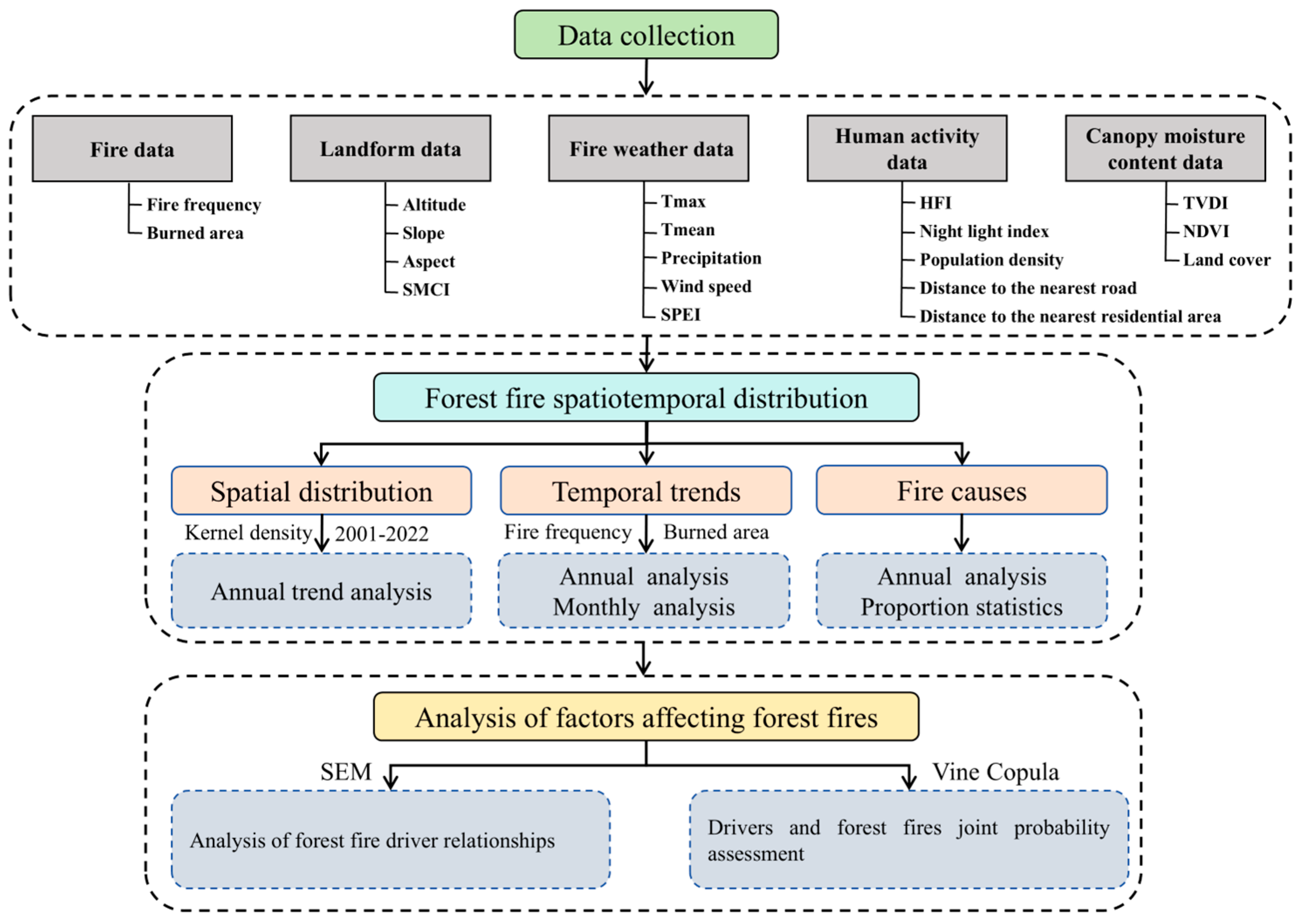


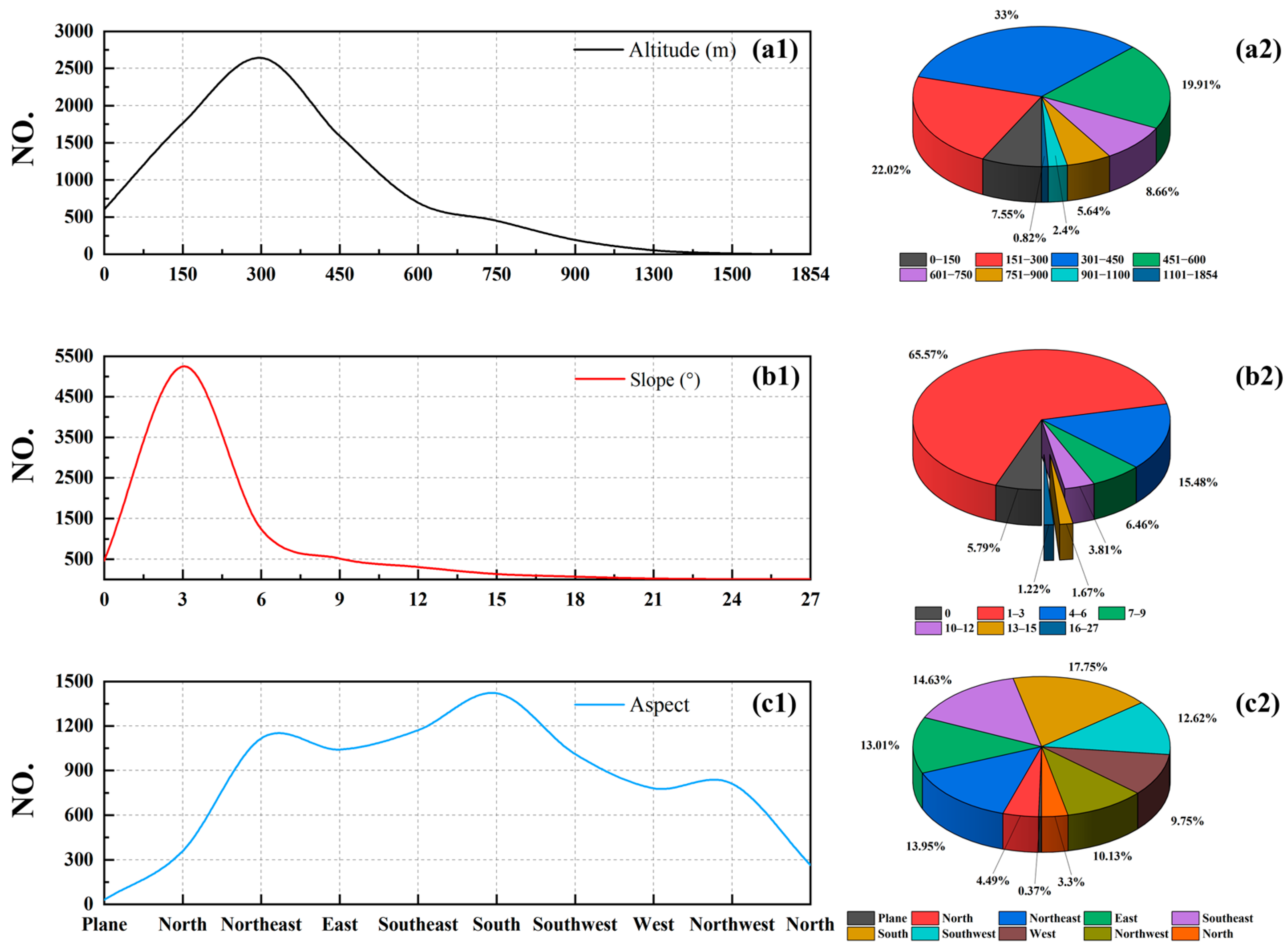

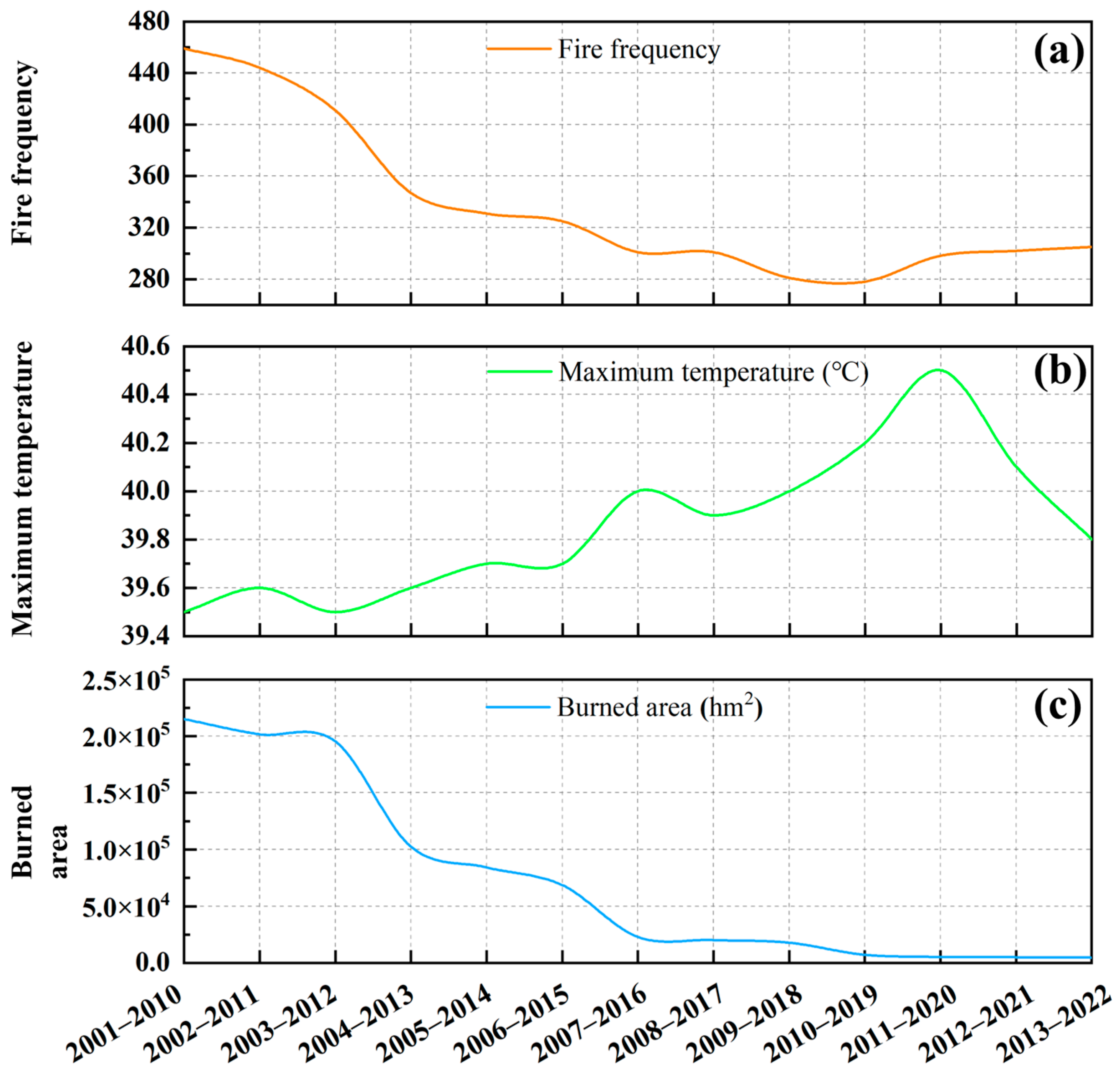
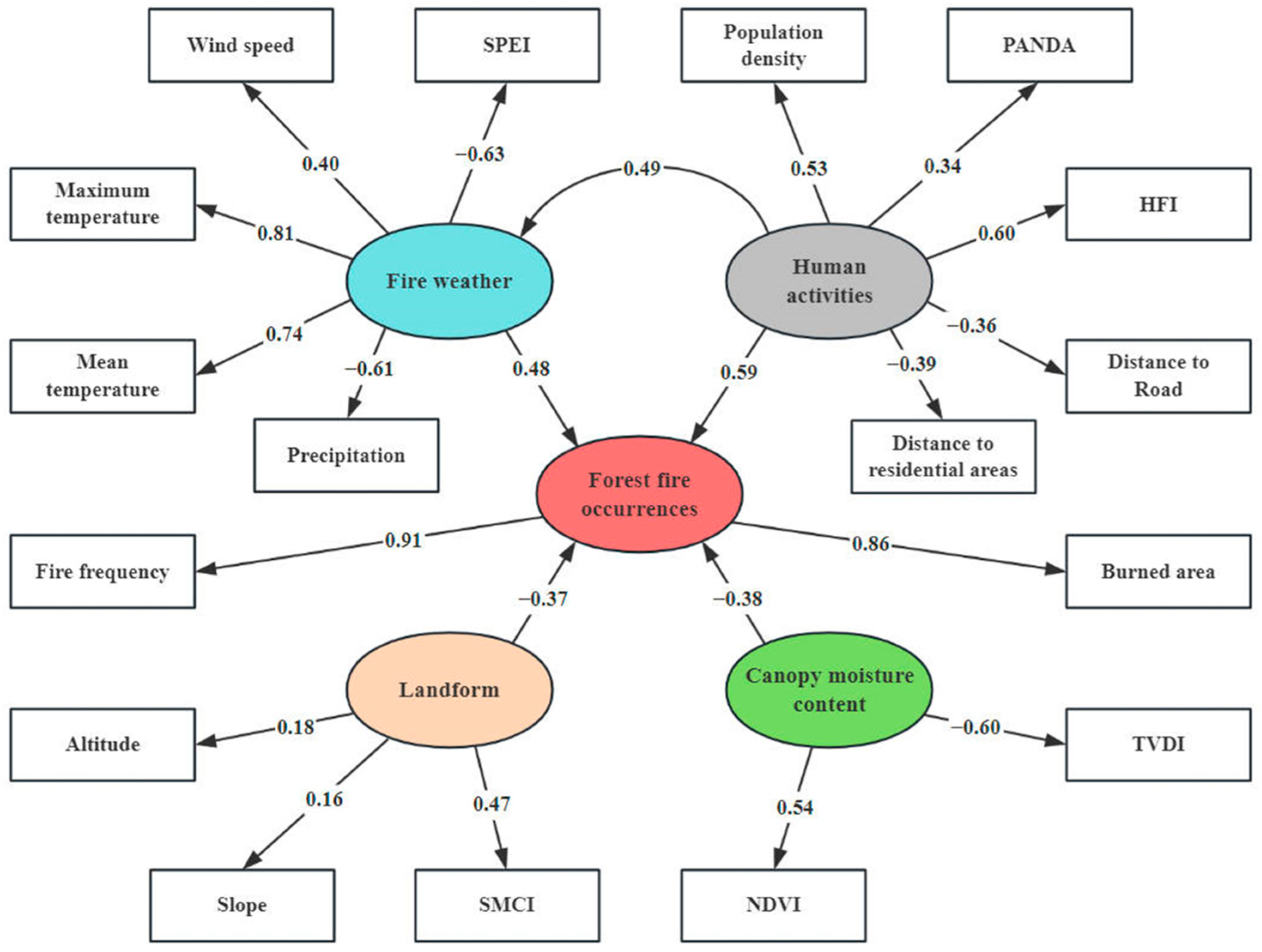

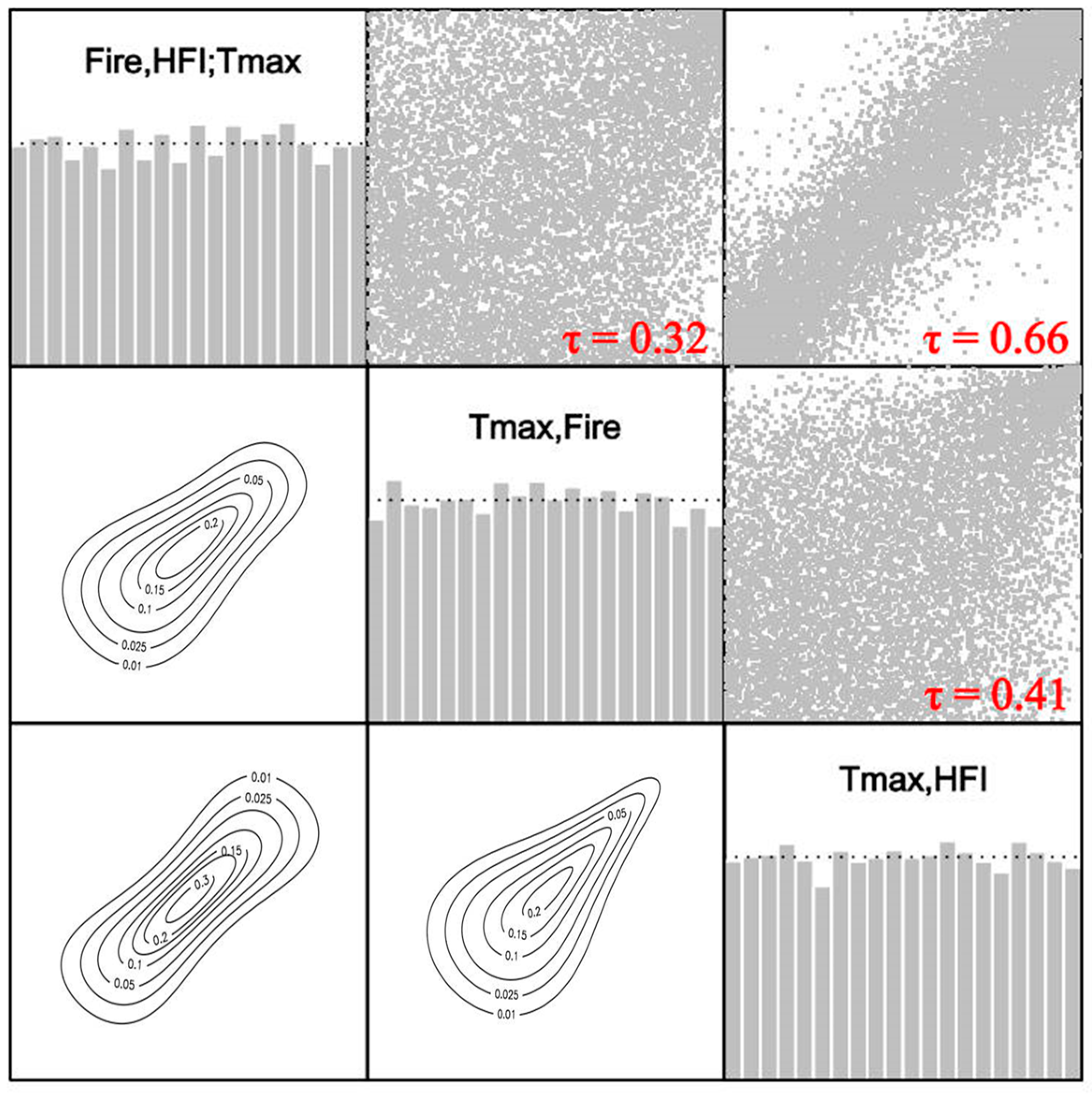
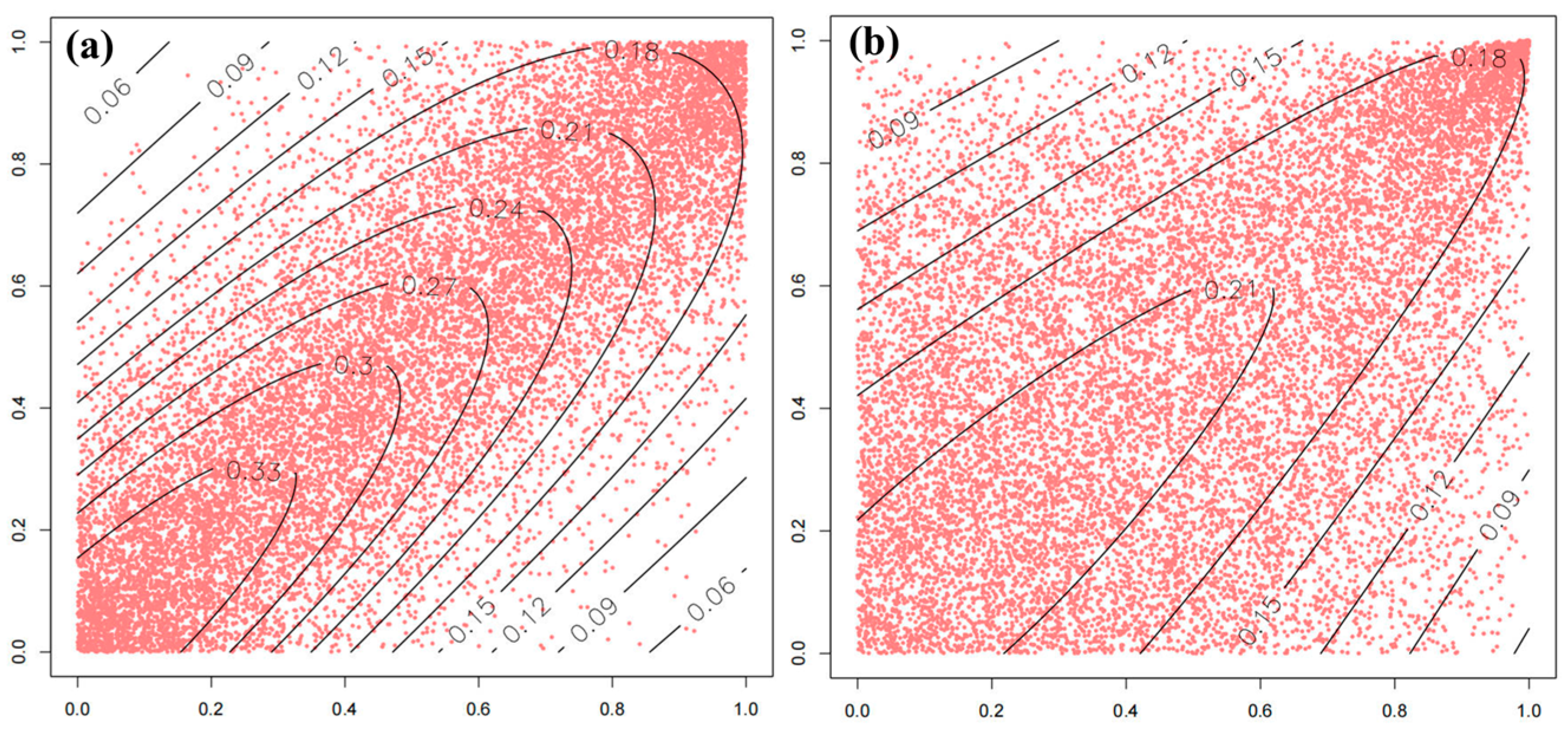
| Types of Data | Variable | Data Sources | Resolution/Time Span |
|---|---|---|---|
| Fire data | Fire frequency | MODIS Active Fire And Burned Area Products https://modis-fire.umd.edu, accessed on 19 March 2025 | 10 km/2001–2022 |
| Burned area | |||
| Canopy moisture content data | Temperature vegetation dryness index | National Earth System Science Data Center https://www.geodata.cn, accessed on 19 March 2025 | 1k m/2001–2022 |
| Land cover data | National Service Center for Specialty Environmental Observation Stations https://www.ncdc.ac.cn, accessed on 16 May 2024 | 30 m/1985–2022 | |
| Normalized difference vegetation index (NDVI) | Third Pole Environment Data Center https://www.re3data.org/repository/r3d100013285, accessed on 19 March 2025 | 1 km/2001–2022 | |
| Fire weather data | Mean temperature | Google Earth Engine https://www.gscloud.cn, accessed on 16 May 2024 | 10 km/1950–2025 |
| Maximum temperature | |||
| Precipitation | |||
| Wind speed | |||
| Standardized precipitation evapotranspiration index (SPEI) | |||
| Landform data | Altitude | Geospatial Data Cloud https://www.gscloud.cn, accessed on 19 March 2025 | 30 m/2001–2022 |
| Slope | |||
| Aspect | |||
| Soil moisture condition index of China by in situ data (SMCI) | National Tibetan Plateau Science Data Center https://data.tpdc.ac.cn, accessed on 16 May 2024 | 1 km/2000–2022 | |
| Human activity data | Population density | OAK RIDGE National Laboratory https://landscan.ornl.gov, accessed on 16 May 2024 | 1 km/2000–2022 |
| Night light index (PANDA) | Third Pole Environment Data Center https://www.re3data.org/repository/r3d100013285, accessed on 19 March 2025 | 1 km/1984–2022 | |
| Distance to the nearest residential area | Open Street Map https://www.openstreetmap.org, accessed on 19 March 2025 | 10 km/2001–2022 | |
| Distance to the nearest road | |||
| Human footprint index (HFI) | China Agricultural University https://www.x-mol.com, accessed on 19 March 2025 | 1 km/2000–2022 |
| Name | Expression | Parameter θ Range |
|---|---|---|
| Gaussian | θ ∈ [−1, 1] | |
| Clayton | θ ∈ [−1, ∞]˄ ≠ 0 | |
| Frank | θ ∈ R˄ ≠ 0 | |
| Gumbel | θ ∈ [1, ∞] |
| Model Fitting Indicators | Indicator Name | Fit Requirement Standard | Actual Value |
|---|---|---|---|
| df | Degree of freedom | / | 48.00 |
| CHISQ (χ2) | Chi square value | / | 65.76 |
| χ2/df | / | 1~3 | 1.37 |
| p-value | Significance test value | >0.05 | 0.08 |
| GFI | Goodness-of-fit index | >0.90 | 0.91 |
| CFI | Comparative fit index | >0.95 | 0.92 |
| SRMR | Standardized root mean square residual | <0.05 | 0.04 |
| RMSEA | Root mean square error of approximation | <0.08 | 0.077 |
| 2D Variables | Family/Copula Family | AIC |
|---|---|---|
| Tmax–Fire | 10/BB8 Copula | −495,253.7 |
| Tmax–HFI | 5/Frank Copula | −103,720.5 |
Disclaimer/Publisher’s Note: The statements, opinions and data contained in all publications are solely those of the individual author(s) and contributor(s) and not of MDPI and/or the editor(s). MDPI and/or the editor(s) disclaim responsibility for any injury to people or property resulting from any ideas, methods, instructions or products referred to in the content. |
© 2025 by the authors. Licensee MDPI, Basel, Switzerland. This article is an open access article distributed under the terms and conditions of the Creative Commons Attribution (CC BY) license (https://creativecommons.org/licenses/by/4.0/).
Share and Cite
Ga, R.; Liu, X.; Ma, B.; Na, M.; Zhang, J.; Tong, Z.; Wei, X.; Xu, J. The Individual and Combined Effects of Natural–Human Factors on Forest Fire Frequency in Northeast China. Remote Sens. 2025, 17, 1685. https://doi.org/10.3390/rs17101685
Ga R, Liu X, Ma B, Na M, Zhang J, Tong Z, Wei X, Xu J. The Individual and Combined Effects of Natural–Human Factors on Forest Fire Frequency in Northeast China. Remote Sensing. 2025; 17(10):1685. https://doi.org/10.3390/rs17101685
Chicago/Turabian StyleGa, Rima, Xingpeng Liu, Bing Ma, Mula Na, Jiquan Zhang, Zhijun Tong, Xiao Wei, and Jing Xu. 2025. "The Individual and Combined Effects of Natural–Human Factors on Forest Fire Frequency in Northeast China" Remote Sensing 17, no. 10: 1685. https://doi.org/10.3390/rs17101685
APA StyleGa, R., Liu, X., Ma, B., Na, M., Zhang, J., Tong, Z., Wei, X., & Xu, J. (2025). The Individual and Combined Effects of Natural–Human Factors on Forest Fire Frequency in Northeast China. Remote Sensing, 17(10), 1685. https://doi.org/10.3390/rs17101685










